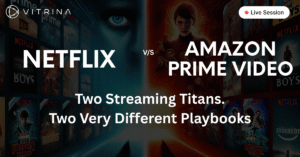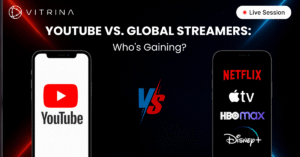The Unscripted Revolution: MGM Alternative Post-Amazon

Introduction
As a strategist in the M&E space, I see companies at an inflection point. The strategic landscape is shifting faster than ever before. But from my perspective, few divisions have navigated this turbulence with the precision and foresight of MGM Alternative (Metro-Goldwyn-Mayer Studios Inc.). The recent consolidation under Amazon’s umbrella has not diminished its identity but has, in my analysis, “force multiplied” its capabilities, to borrow a phrase from Vernon Sanders, the Head of Global Television at Amazon MGM Studios. This article is for the executive who needs to look beyond the headlines and understand the intricate business model that has transformed MGM Alternative into an unscripted powerhouse—a division that is not just surviving the streaming wars but defining them.
Key Takeaways
| Core Challenge | The M&E industry faces fragmentation, with unscripted content having to prove its value across an increasingly complex multi-platform landscape to remain profitable. |
| Strategic Solution | MGM Alternative is addressing this by building a “streaming-first” model focused on premium production values, multi-platform monetization, and data-informed content decisions. |
| Vitrina’s Role | Vitrina provides the core business intelligence and project tracking necessary for executives to identify key players, understand their strategic moves, and find new partnership opportunities within this dynamic ecosystem. |
The Barry Poznick Philosophy: MGM Alternative’s Blueprint for Profitability
The strategic success of MGM Alternative cannot be discussed without a deep dive into the business philosophy of its President, Barry Poznick. In my professional opinion, Poznick’s approach is a masterclass in modern content strategy, blending creative vision with a sharp focus on financial viability and multi-platform distribution. The core tenets of his philosophy are profitability, scalability, and a “very, very buttoned up” approach to development.
Poznick operates with the belief that “every idea needs to be profitable from the start.” This stands in stark contrast to the old model of content creation, which often relied on a single, primary revenue stream (e.g., network licensing fees). Instead, his team develops concepts that are inherently designed for multiple revenue points. This means considering how a show can not only work for a streamer but also generate sales from integrated products, leverage social media for fan engagement, and be monetized on new distribution channels like YouTube and Free Ad-Supported Television (FAST) channels. According to a blog post on Vitrina’s own site, Poznick views YouTube as serving the same function that syndication once did for traditional television, providing a new, profitable channel for content (Vitrina Blog, “MGM Alternative: Reinventing Reality TV for a Streaming-First Era,” 2025). This forward-thinking approach is what makes MGM Alternative’s IP so durable and valuable in a fragmented media landscape.
His philosophy also emphasizes scalable storytelling. This is about creating formats that can thrive across different production values and platforms. For instance, a core format might be a high-budget premium series for Prime Video, but the same IP can be adapted into a lower-cost, high-volume production for a FAST channel or a digital-native series for social media. This flexibility allows MGM Alternative to extract maximum value from its IP, a critical capability in an industry where audience attention is scattered across dozens of platforms.
The development process itself is rigorous. Poznick does not pitch a show without having everything “figured out”: the talent, the production model, the financing, and the marketing plan. This is a level of strategic discipline that is increasingly rare and demonstrates a fundamental shift from a volume-based approach to a value-based one.
For a distribution executive or content acquisition leader, this philosophy is a clear signal. You are not just buying a show; you are entering into a partnership with a team that has already mapped out the entire life cycle of that IP. However, this raises a new challenge: how do you get visibility into a company’s entire slate of projects—from development to production—to identify these opportunities before they are locked up? The old model of waiting for press releases or attending pitch meetings is no longer sufficient. You need an automated, real-time solution for tracking projects globally. Vitrina’s Film+TV Projects Tracker provides this by tracking projects from the earliest stages of development, linking them to key companies and decision-makers. My analysis indicates that this capability is essential for any executive looking to stay ahead of the curve and identify lucrative partnerships.
Scaling Beyond the Screen: How MGM Alternative is Optimizing Its Content
In a saturated market, success is measured not just by a show’s ratings but by its ability to create a sustainable ecosystem. MGM Alternative, under Poznick’s leadership, understands this. The division’s strategy is not limited to linear or on-demand content; it is a holistic approach to content optimization across the media landscape, including social, digital, and FAST channels.
A prime example of this is the division’s focus on creating formats that are inherently “gamified” or “interactive.” Poznick believes that unscripted content, unlike scripted dramas, can lean into a “choose your own adventure” type of experience for viewers. This is a direct response to the younger, digitally native audience, who are accustomed to interacting directly with creators and influencers. By incorporating interactive elements, MGM Alternative is not just broadcasting content; it is building engaged communities. This strategy is critical for creating durable IP that can live on long after the initial broadcast. For example, a show’s format can be translated into a mobile game or a social media-driven competition, generating new revenue streams and extending the life of the franchise.
Furthermore, the strategic use of FAST channels is a cornerstone of MGM Alternative’s model. These channels, which are essentially free, ad-supported linear streams, provide a new avenue for monetizing library content and reaching a wider audience. MGM Alternative’s parent, Amazon MGM Studios, has the infrastructure in place to leverage these channels effectively. By placing its content on FAST channels, the division can generate ad revenue, build awareness for its flagship series, and even use these platforms to test new formats at a lower cost. This multi-pronged distribution strategy, which combines premium streaming with ad-supported linear and social content, ensures that every piece of IP is working to its full potential.
Leveraging the Amazon Ecosystem: The Strategic Placement of MGM Alternative (Metro-Goldwyn-Mayer Studios Inc.)
The acquisition by Amazon transformed MGM Alternative from a standalone production studio into a strategic asset within one of the world’s most powerful media and technology ecosystems. The value proposition extends far beyond a simple content library. For a senior executive, it’s about understanding the synergies and “force multipliers” that this integration creates.
The most significant synergy is the direct access to Amazon’s global audience via Prime Video and Freevee. This allows MGM Alternative to bypass traditional distribution gatekeepers and reach over 200 million Prime members worldwide. This is a game-changer for IP with global appeal, as seen with their worldwide rights sale for Are You Smarter Than a Celebrity? to Prime Video, which premiered in 240 territories on the same day. This level of scale and simultaneous global distribution is something that traditional network models simply cannot match.
Furthermore, MGM Alternative can leverage Amazon’s immense technological and data infrastructure. While Poznick has noted the potential of AI in production, from casting to creating titles, the true power lies in Amazon’s data analytics. This data can inform everything from development decisions to marketing strategies, ensuring that content is not just creatively compelling but also strategically aligned with audience trends and viewing habits. The integration also opens up new opportunities for cross-promotional activity within the Amazon ecosystem, bundling entertainment content with e-commerce, advertising, and other services. This creates a powerful, self-reinforcing loop that drives both viewership and overall customer engagement.
From an M&E executive’s perspective, this level of strategic integration is a powerful signal. It demonstrates a commitment to a modern, data-driven approach to content. The challenge, however, is gaining a granular understanding of these intricate relationships. How do you track not just the projects themselves but also the specific partnerships, distribution deals, and key contacts involved in each one? This is where a specialized intelligence platform becomes indispensable. Vitrina’s ability to map corporate ownership, track a company’s deal track record, and provide verified contact information for millions of executives provides a critical advantage in this new ecosystem. My analysis indicates that for any executive looking to partner with or compete against Amazon MGM Studios, this intelligence is the key to unlocking opportunities and mitigating risks. This deep understanding of the M&E supply chain is what we, as strategists, bring to the table.
Vitrina’s Role in a Data-Driven Content Strategy
In the modern M&E landscape, the ability to make data-driven decisions is no longer a competitive advantage—it’s a necessity. This is where Vitrina, as the definitive business intelligence platform for the entertainment supply chain, becomes a critical tool. My analysis indicates that for executives dealing with the complexities of this industry, Vitrina serves as a single source of truth, centralizing the fragmented data that traditionally hinders deal-making.
For a content acquisition executive, this means gaining an “early warning” on projects before they become public knowledge. Vitrina’s Film+TV Projects Tracker continuously monitors the global production pipeline, tracking projects from the development and financing stages all the way through to post-production. This allows you to identify new content opportunities, gauge their potential, and initiate contact with the key decision-makers—the producers, financiers, and distributors—before the market is aware of the project. This proactive approach eliminates the risk of being caught off guard when a competitor announces a deal you were not even aware was in play.
Beyond project tracking, Vitrina’s core value lies in its ability to connect the dots. The platform profiles over 2.7 million companies globally, mapping relationships and providing verified contact information for millions of executives. This allows a leader to not only find a potential partner but to also vet them instantly by reviewing their deal track record, specializations, and past collaborations. This is how you transform a reactive, manual research process into a strategic, intelligence-led workflow, ensuring every deal is built on a foundation of solid, verifiable data.
Ultimately, Vitrina’s role is to provide the comprehensive, real-time intelligence needed to navigate an opaque and rapidly evolving industry. It’s the platform that helps you move beyond a simple contact list to a strategic map of the global M&E supply chain, enabling you to make more efficient, informed, and profitable decisions.
Tools
Conclusion
In my analysis, MGM Alternative is more than just a production division; it is a blueprint for how a legacy content creator can thrive in the modern, multi-platform era. Its success is a testament to a strategic vision that prioritizes profitability, scalability, and deep integration into a powerful ecosystem. For any executive in the M&E supply chain, understanding this strategic evolution is crucial. The key to staying ahead lies not in reacting to industry trends, but in having the real-time, comprehensive intelligence to anticipate them.
Frequently Asked Questions
MGM Alternative is the unscripted and reality television division of Amazon MGM Studios. It is responsible for producing and distributing a wide range of reality series and entertainment formats, including major global franchises like Survivor, The Voice and Shark Tank.
The division is currently led by Barry Poznick, President of MGM Unscripted Television. He reports to Vernon Sanders, the Head of Global Television at Prime Video & Amazon MGM Studios.
Amazon acquired MGM to bolster its content library with a deep catalog of film and television IP. MGM Alternative’s portfolio of durable, globally recognized unscripted franchises was a key strategic asset that enhanced Prime Video’s competitive position in the streaming market.
MGM Alternative has shifted from a traditional broadcast model to a “streaming-first” and multi-platform approach. This strategy focuses on creating premium content with cinematic production values and monetizing it across a variety of platforms, including streaming services, FAST channels, and social media.
To know more about the influential individuals like Barry Poznick, who are featured on our podcasts and are driving the unscripted revolution, explore their profiles in our leader categories.















































